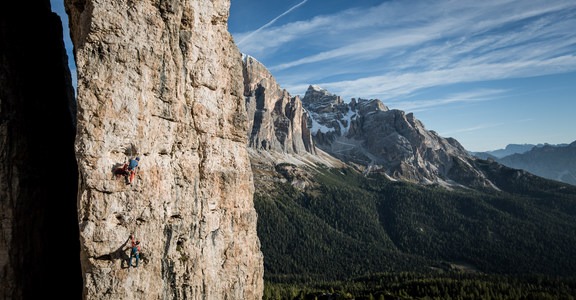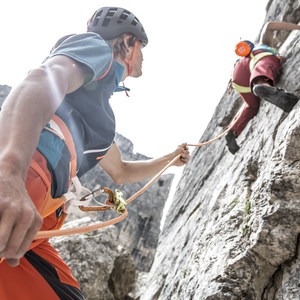Coiling a climbing rope
The rope is the climber’s life insurance policy. The climber must work carefully when climbing, but he/she must be just as careful when coiling the rope. Kinks and knots don’t just waste time on the rock face – they also damage the rope. The rope must therefore be checked for weak spots every time it is coiled. If the rope is damaged, it must be replaced without delay.
When coiling the rope the climber may use a different method according to his/her preferences: From the middle or the end of the rope, from the hand or over the shoulder. During alpine climbs it is helpful to coil the rope so that the climber can carry it comfortably and securely during ascent and descent.
From the center
If the climber picks up the rope from the center, this will encourage kinks to form on their own at the end of the rope. First you look for the midpoint marking. Then – beginning in the center – the mirrored loops are wrapped in the climber’s hand or around his/her shoulder. The loops are coiled from one side to the other until there are two meters of rope remaining. The climber then wraps this very tightly around the loops of rope several times before pulling a loop through the hole. This loop is then placed on top of the upper part. Finally, both ends of the rope are pulled through.
From the end of the rope
Coiling the rope is quick and easy from the ends of the rope The rope is coiled loop by loop over the climber’s hand or his/her shoulder until there are around two meters left to the other end of the rope. The climber then wraps this end several times around the loops of rope very tightly before pulling a loop through the hole. The loop is then placed over the upper part of the rope. Finally, the end of the rope is pulled through tightly.
Butterfly coil
A butterfly coil can be prepared using both methods. From the center: If the climber has coiled the rope, there must be at least three or four meters left at the end of the rope. The climber now wraps the rope ends very tightly around the loops of rope several times before finally pulling a loop through the hole. This loop is then placed on top of the upper part and the ends of the rope pulled through tightly. Now the rope can be carried on the climber’s back. The ends of the rope should be placed over the shoulders onto the climber’s chest and then go under the diagonal armpit back to the rope coil. Then the rope is pulled back through from behind and tied at the stomach.
If the rope has been coiled from the end of the rope, there must be at least three meters left at both ends of the rope. If the rope has been coiled, the ends of the rope are wrapped tightly around the loops of rope before a loop is placed over the upper section and the ends of the rope pulled through. Now the process is the same as the above: The rope is placed on the climber’s back, the ends of the rope are placed over the shoulders onto the chest, threaded back diagonally under the armpits and then pulled through from behind again and tied together.
Check out the full series of Safety Academy Lab Rock videos below:
- Alpine basics
- Basic equipment for every climber
- Basic equipment for groups
- Additional equipment for groups
- Storms in the mountains
- Types of rock in the Alps
- Tour planning for alpine climbing
- Packing a backpack correctly
- Rope team procedures
- Knot techniques
- Belay using bolts
- Belay methods
- Anchors
- Coiling a climbing rope
- Rappelling
- What to do in an alpine emergency
- First aid on the mountain
- Rescue techniques while alpine climbing
- Bivouacking in an emergency situation
Visit ORTOVOX’s Safety Academy Lab Rock to view the climbing tutorials in their totality and test your knowledge with their fun and interactive quizzes.
Since the company was founded in 1980 in the south of Munich, ORTOVOX has stood for the highest possible protection during alpine activities. As pioneers in the avalanche safety field, we have played a key role in the development of emergency equipment for the mountains. Innovations such as the double-frequency avalanche transceiver and Smart Antenna Technology, and also targeted training measures, continue to be valuable contributions to making mountain sports a little bit safer and to saving lives.






Comments
Sign In and share them.